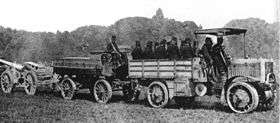Tracteur Panhard-Châtillon
The Tracteur Panhard-Châtillon (French pronunciation: [tʁaktœʁ panaʁ(d) ʃatijɔ̃ ] was a conventional-cabin, all-wheel drive truck produced between 1911 and 1918 by the French manufacturer Panhard. It was one of the first all-wheel drive trucks used by the French military.
| Tracteur Panhard-Châtillon (K11/13)[1] | |
|---|---|
 1914 version | |
| Overview | |
| Manufacturer | Société des Anciens Établissements Panhard et Levassor |
| Also called |
|
| Production | 1911–1918[1] |
| Assembly | Paris, France |
| Layout | Front-engine, four-wheel drive |
History
In the early 1910s, after some French government-sponsored trials of new traction systems, a retired French militaryman surnamed DePort, which was the technical advisor of a metallurgical company called Compagnie des Forges de Châtillon-Commentry, decided to develop a new all-wheel drive vehicle. He partnered with the automotive company Société des Anciens Établissements Panhard et Levassor through its then manager Arthur Krebs[1][2] The new vehicle manufactured by Panhard et Levassor, the Tracteur Panhard-Châtillon (or Châtillon-Panhard), was tested by a French government commission for the first time in 1911.[3] Later, the truck, along with other vehicles designed for difficult terrains, was tested by the French military in 1911, 1912 and 1913. At the tests, the Tracteur Panhard-Châtillon achieved good results. At further tests conducted in 1914, however, it failed as the other vehicles, so minor tests were conducted afterwards.[1] The French military requested the assembly of about 50 vehicles.[4] The Panhard-Châtillons were the only hauling transports used by France for its artillery units that were not horse-drawn at the First Battle of the Marne.[5]
Technical details
The Panhard-Châtillon had a sleeve-valved 8.8-litre inline-four petrol engine which delivered between 40 metric horsepower (29 kW) and 42 metric horsepower (31 kW).[1][6] At the early tests, it used a 6.6-litre inline-six engine which delivered 45 metric horsepower (33 kW) at about 1,000 rpm.[6] The truck had no universal joints and it mounted a central differential gear. It had a 3-speed gearbox. The Panhard-Châtillon had a four-wheel steering system by which the parallel wheels were linked, not the wheels on the same axle.[7] This allowed the Châtillon-Panhard closer turning radius that comparable vehicles.[7] The wheels were made of cast steel.[8]
The wheelbase of the truck was 3,320 mm (131 in), the length 4,850 mm (191 in), the width 1,450 mm (57 in) and the height 1,000 mm (39 in) (without the roof).[9] The heavier produced versions had slightly larger dimensions.[1] It had a payload capacity of 2,430 kilograms (5,360 lb)[9] and could haul about 15 tonnes.[4]
References
Citations
- Guerre, Blindés et Matériel 2007, pp. 14–25.
- Ferrus 1913, p. 275.
- Ferrus 1913, pp. 283–284.
- Dardinier.
- Sumner 2012, p. 17.
- Ferrus 1913, p. 277.
- Ferrus 1913, pp. 275–276.
- Ferrus 1913, p. 281.
- Ferrus 1913, p. 282.
Bibliography
- Ferrus, L. (1913). "Le tracteur Châtillon-Panhard à adhérence totale" [The total-adherence Tracteur Châtillon-Panhard]. Revue d'artillerie (in French). Nancy: Berger-Levrault. 82. ISSN 2019-8396.CS1 maint: ref=harv (link)
- "K11 et K13 tracteurs" [K11 and K13 tractors]. Guerre, Blindés et Matériel (in French). Paris: Histoire et collections (76). 2007. ISSN 1956-2497.
- Dardinier, Jean Pierre. "Avant la première guerre mondiale, déjà un camion français 4x4 !" [Before World War I, it there already was a French 4x4 truck] (in French). MVCG France. Retrieved 17 October 2016.CS1 maint: ref=harv (link)
- Sumner, Ian (2012). "Opposing Forces". The First Battle of the Marne 1914: The French "miracle" halts the Germans. Bloomsbury Publishing. ISBN 978-1-84603-502-9.CS1 maint: ref=harv (link)